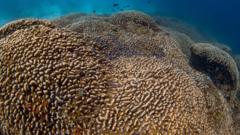Researchers have identified the largest coral ever recorded in the Pacific Ocean, measuring 34 meters wide and over 300 years old. This finding highlights the need for protective measures for vital marine ecosystems overshadowed by climate change's impacts.**
Discovery of the World’s Largest Coral: A Natural Wonder and Call for Protection**

Discovery of the World’s Largest Coral: A Natural Wonder and Call for Protection**
Scientists uncover a vast coral system in the Pacific, emphasizing its significance amid climate change challenges.**
The largest coral ever documented has been discovered in the southwest Pacific Ocean, surprising local communities who were unaware of its existence. This remarkable organism, a massive assembly of tiny interconnected creatures, is estimated to be more than 300 years old, growing larger than a blue whale.
The discovery came during a National Geographic expedition aimed at assessing climate change's impacts on remote Pacific locations. Diver and videographer Manu San Felix, who stumbled upon the coral while investigating a shipwreck, described it as a breathtaking "cathedral underwater," sparking a deep sense of respect for this ancient living structure.
The coral, located in the Solomon Islands, measures 34 meters wide, 32 meters long, and 5.5 meters high. During the dive, San Felix remarked, “I thought, 'Wow, this was here when Napoleon was alive,'" recognizing the historical significance of the marine entity.
Corals globally face significant threats from warming ocean temperatures, which endanger the delicate ecosystems that provide critical habitats for diverse marine life and sustain the livelihoods of approximately one billion people worldwide. The newly-found coral, however, appears to be in good health, sheltered in deeper waters away from the stressors affecting shallow reefs.
The unveiling of this coral coincpected with the UN climate meetings at COP29 in Baku, Azerbaijan, where Solomon Islands' climate minister Trevor Manemahaga stressed the importance of preserving such natural treasures. “We want the world to know that this is a special place and it needs to be protected,” he stated, noting the vital role of coral systems in the country’s economy and ecological balance.
Small island nations like the Solomon Islands are especially vulnerable to climate change, facing stronger storms and coastal erosion. Manemahaga emphasized the need for increased financial support from developed nations to enable his country to devise sustainable economic alternatives that do not exploit its coral populations.
Currently, logging generates significant revenue for the Solomon Islands but leads to pollution that harms the marine ecosystem. Coral scientist Eric Brown, part of the National Geographic team, expressed optimism as they observed the healthy coral amidst otherwise degraded shallow reefs, viewing it as a "beacon of hope" for climate-adverse areas.
The coral species discovered is Pavona clavus, providing habitats for various marine species like shrimp, fish, and crabs. Its age allows scientists to investigate past oceanic conditions, advancing understanding of marine life resilience against environmental shifts.
Recent assessments by the International Union for the Conservation of Nature reveal that 44% of corals in warm waters are now at risk of extinction, highlighting the urgency of conservation efforts as marine ecosystems face unprecedented threats due to climate change impacts.





















